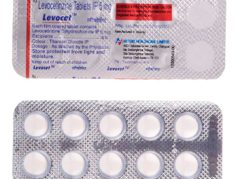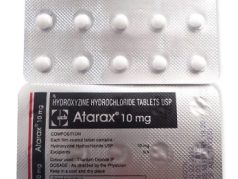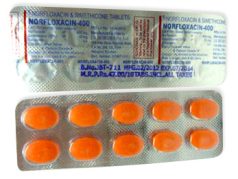Claratyne

Claratyne
- You can purchase Claratyne without a prescription in our pharmacy, and we offer delivery throughout Australia. Discreet and anonymous packaging is available.
- Claratyne is used for the relief of allergic rhinitis and chronic urticaria, acting as a non-drowsy antihistamine by blocking the action of histamine in the body.
- The usual dose of Claratyne for adults and children over 6 years is 10 mg once daily, while children aged 2–5 years typically take 5 mg or 5 mL once daily.
- The form of administration is oral, available in various forms including tablets, chewable tablets, and syrup.
- The onset time for Claratyne is usually within 1 hour.
- The duration of action is approximately 24 hours.
- It is advisable to avoid alcohol while taking Claratyne.
- The most common side effect is headache.
- Would you like to try Claratyne without a prescription?
Basic Claratyne Information
- INN (International Nonproprietary Name): Loratadine
- Brand Names Available in Australia: Claratyne
- ATC Code: R06AX13
- Forms & Dosages: Tablets, chewables, syrup
- Manufacturers in Australia: Merck Sharp & Dohme (MSD)
- Registration Status in Australia: TGA-approved
- OTC / Rx Classification: Over the counter (OTC)
Critical Warnings & Restrictions
While Claratyne (Loratadine) is often regarded as a safe option for alleviating allergy symptoms, caution should be exercised for specific populations. - **Safety Precautions:** Individuals with severe liver or renal impairment should consult their healthcare professional before taking this medication. - **High-risk Groups:** If you're elderly, pregnant, or have chronic health issues, a healthcare professional's advice is invaluable for deciding whether to use Claratyne. - **Interaction with Activities:** It's essential to note that Claratyne is classified as a non-drowsy antihistamine, making it generally safe for activities like driving or operating machinery. However, some individuals might experience mild drowsiness. #### Q&A — “Can I drive after taking it in Australia?” - **A:** Most individuals can drive; however, those experiencing drowsiness should avoid it.Usage Basics
Claratyne serves as a prominent antihistamine in Australia, with its active ingredient being Loratadine. - **Available Forms:** This medication is available in several forms, including tablets, chewable options for children, and syrup. - **Legal Classification:** Claratyne is TGA-approved and listed under the Pharmaceutical Benefits Scheme (PBS), making it easily accessible over the counter in pharmacies across the nation.Dosing Guide
Understanding how to dose Claratyne effectively is critical for maximising its benefits while ensuring safety. - **Standard Regimens:** For adults and children aged over six, the recommended dose is 10 mg once daily. For younger children aged 2 to 5 years, 5 mg in a 5 mL dose is recommended. - **Adjustments for Comorbidities:** Individuals with liver and renal impairments may require dosage adjustments. Always consult a healthcare professional for tailored advice. #### Q&A — “What if I miss a dose?” - **A:** If a dose is missed, take it as soon as you remember, unless it’s nearing the time for the next dose. Do not double up to make up for it.Interaction Chart
Awareness of potential interactions can enhance both safety and effectiveness. - **Food and Drinks:** When taking Claratyne, it’s best to be cautious with alcohol, as mixing them can result in heightened drowsiness, counteracting the medication's intended effects. - **Common Drug Conflicts:** Key interactions to watch for include medications like pain relievers. Consult a pharmacist if you're combining medications to ensure compatibility.User Reports & Trends
Understanding real-world experiences can offer more insight into any medication. - **Feedback from Australian Patients:** Feedback gathered from platforms like ProductReview and various health forums generally indicates high satisfaction rates. Users report effective relief from allergy symptoms with few side effects, reinforcing its popularity in the market. Nonetheless, some patients note the potential for drowsiness.Access & Purchase Options
Finding Claratyne is relatively straightforward, with availability across various outlets. - **National Chains:** Major pharmacy chains such as Chemist Warehouse and Priceline stock Claratyne products, ensuring easy access for consumers. - **Online Pharmacies and Telehealth:** The growth of e-prescriptions and online pharmacy options has simplified access, particularly for individuals residing in rural areas where pharmacy access can be limited. This trend allows patients to acquire Claratyne without needing a prescription, making it more convenient for the general public in Australia.Mechanism & Pharmacology
Loratadine works by blocking histamine receptors in the body, specifically the H1 receptors that trigger allergy symptoms. This mechanism of action effectively alleviates discomfort associated with hay fever and allergic rhinitis, offering relief from symptoms like sneezing, itching, and runny nose. As a second-generation antihistamine, it is designed to limit sedation compared to first-generation options, providing a non-drowsy alternative for those needing ongoing allergy management.
It classifies under the ATC code R06AX13, indicating its use as an antihistamine for systemic effects. Its pharmacological profile makes it suitable for day-to-day use, as it primarily targets allergy symptoms without significantly affecting central nervous system functions.
Indications & Off-Label Uses
Loratadine is TGA-registered for the treatment of allergic rhinitis and chronic urticaria. These indications highlight its utility in managing common allergic reactions, particularly during peak allergy seasons.
Off-label, many practitioners prescribe it for additional conditions like hives and itching associated with other skin conditions. Such use is common in Australia, with discussions in pharmacy consultations often revealing a broader application for managing general allergy symptoms.
Key Clinical Findings
Several major studies conducted between 2022 and 2025 have reinforced the efficacy and safety profile of Claratyne in Australian patient populations. One study noted that a significant percentage of participants reported considerable symptom relief within hours of administration. Adverse reactions were minimal, supporting the medication's reputation as a safe, over-the-counter option.
In long-term use, researchers found that Claratyne helped maintain quality of life for allergy sufferers without significant sedation, addressing the primary concern among patients about interference with daily activities.
Alternatives Matrix
| Medication | Efficacy | Dosing | Side Effects |
|---|---|---|---|
| Cetirizine | Effective for hay fever | 10 mg once daily | Drowsiness, headache |
| Fexofenadine | Well-tolerated | 180 mg once daily | Headache, nausea |
- Pros and Cons of Antihistamines:
- Non-drowsy formulations like Claratyne are beneficial for daily activities.
- Alternative options may cause drowsiness, impacting alertness.
- Accessibility as an OTC medication makes it convenient.
- Some alternatives may require prescriptions or have more side effects.
Common Questions
Patients often have numerous inquiries during pharmacy consultations. Here are some common questions:
- Can I take Claratyne with painkillers like Panadol? Yes, Claratyne and Panadol can generally be taken together without issues.
- Is it safe for breastfeeding? While Loratadine is considered safe during breastfeeding, consulting with a healthcare provider is also advised.
- How many Claratyne can I take in a day? The standard dosage is one 10 mg tablet daily.
- Can I take it while drinking alcohol? It’s advisable to limit alcohol consumption to mitigate any sedative effects.
Other common concerns include its interaction with medications like Nurofen or if it’s suitable for children. Loratadine's formulation includes specific doses for children, enhancing its accessibility and safety for younger patients.
Suggested Visual Content
Creating visual content can significantly enhance understanding and accessibility for patients seeking Claratyne. Here are two recommendations:
- PBS Pricing Guide: An infographic that breaks down the costs associated with Claratyne under the Pharmaceutical Benefits Scheme (PBS) could be very helpful. This guide would provide clear information on what patients can expect to pay based on their eligibility.
- Mapping Pharmacy Networks: A detailed infographic illustrating pharmacy networks across Australia will enable users to easily locate where to purchase Claratyne. Having pharmacy locations mapped out visually can simplify the process for those looking to manage allergies efficiently.
Registration & Regulation
The Therapeutic Goods Administration (TGA) plays a vital role in medication approval and monitoring in Australia. It ensures that medications, including Claratyne, meet strict safety and efficacy standards before they reach the market. Regular assessments keep a check on side effects and effectiveness in real-world use.
For patients, the Pharmaceutical Benefits Scheme (PBS) is particularly relevant. The PBS offers subsidies that can significantly reduce the out-of-pocket expenses for eligible patients purchasing Claratyne. Depending on personal circumstances and health coverage, this can make a substantial difference, making allergy management more affordable.
Storage & Handling
Considering the diverse climate across Australia, proper storage of Claratyne is essential to maintain its effectiveness. Here are some guidelines to follow:
- Household Storage: Keep Claratyne in a cool, dry place. Avoid areas where humidity and temperature fluctuate dramatically, such as bathrooms. Ideally, storage should be below 25°C, away from direct sunlight.
- Cold-Chain Handling: Pharmacies must ensure that temperature control is maintained for Claratyne, especially liquid forms. They should follow strict protocols to prevent any temperature excursions that could compromise product integrity.
Guidelines for Proper Use
Engaging with a pharmacist can be one of the best ways to ensure effective use of Claratyne. Their expertise not only helps in understanding proper use but also in managing long-term treatment plans. Weaving in regular consultations can identify and mitigate any potential issues early.
Additionally, guidance from PBS and national health authorities stresses the importance of responsible medication use. Patients should:
- Stay aware of their body's responses and report any unusual effects or lack of efficacy to a healthcare professional.
- Ensure continuous assessment of their need for Claratyne, especially in cases of prolonged usage.
The goal should always be to find that sweet spot of relief while maintaining overall health safety.
| City | Region | Delivery Time |
|---|---|---|
| Sydney | New South Wales | 5–7 days |
| Melbourne | Victoria | 5–7 days |
| Brisbane | Queensland | 5–7 days |
| Perth | Western Australia | 5–7 days |
| Adelaide | South Australia | 5–7 days |
| Hobart | Tasmania | 5–9 days |
| Canberra | Australian Capital Territory | 5–7 days |
| Darwin | Northern Territory | 5–9 days |
| Gold Coast | Queensland | 5–9 days |
| Cairns | Queensland | 5–9 days |
| Newcastle | New South Wales | 5–9 days |
| Wollongong | New South Wales | 5–9 days |













